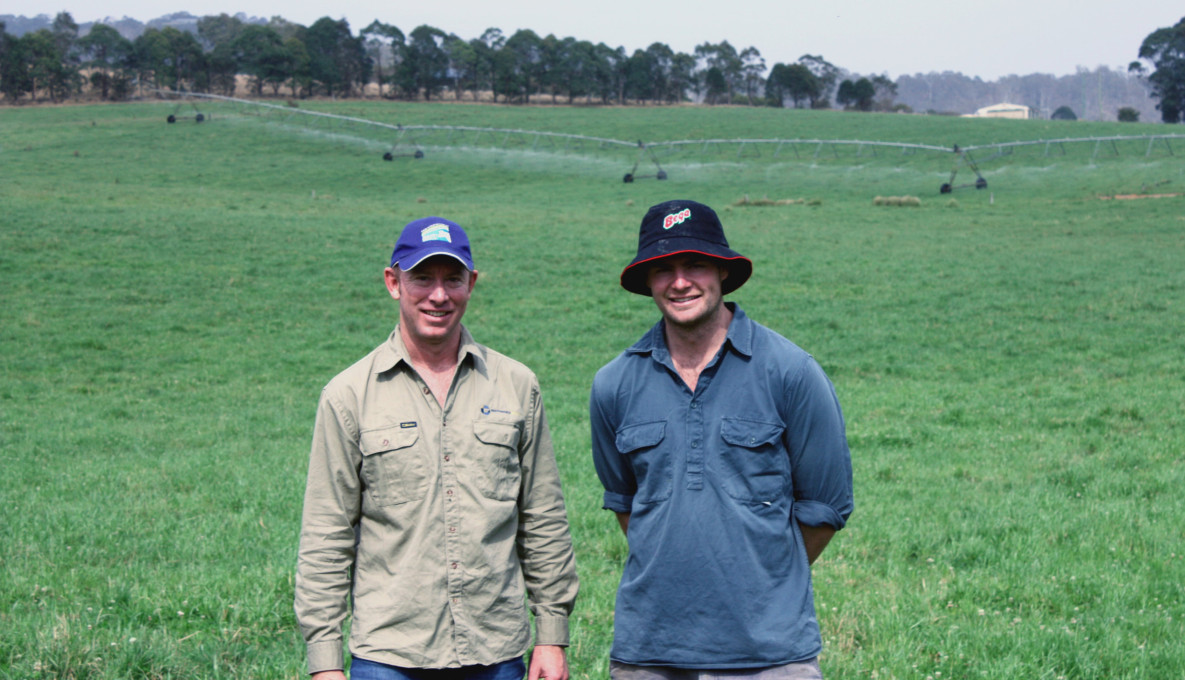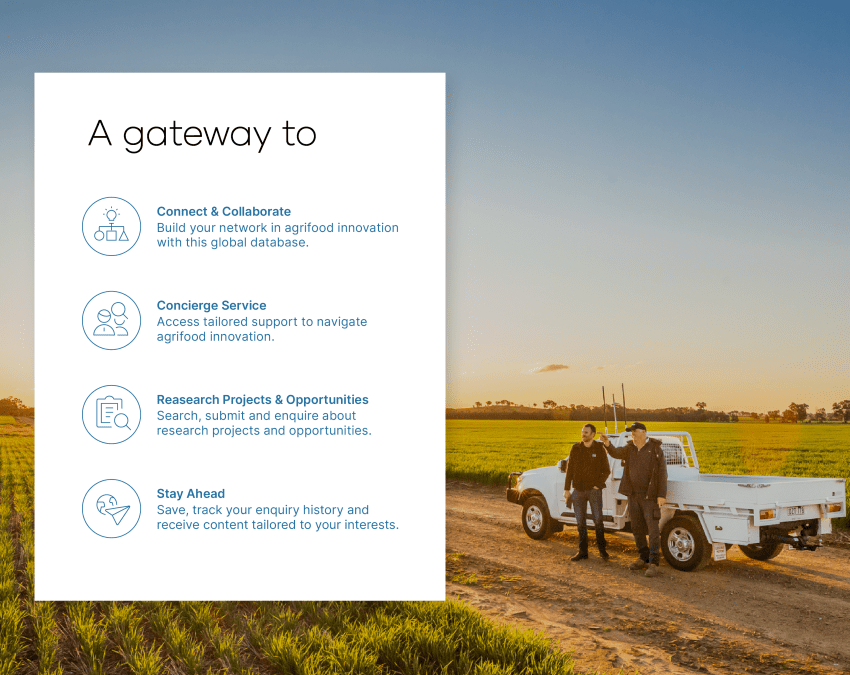-contain-250x120.jpg)
Technology the key to increasing yields for Bega, NSW farmer
Smarter irrigation technology, like soil moisture probes with real-time telemetry, has become an integral tool for New South Wales dairy farmer Will Russell, enabling him to grow more feed and increase herd size.
Will is one of the farmers across Australia who partners in the Smarter Irrigation for Profit Phase 2 (SIP2) program which provides an opportunity for dairy irrigators to closely monitor the impact of irrigation optimisation strategies, and take-up opportunities to increase their knowledge on the practical tools and support available to help in irrigation decisions.

Smarter irrigation technology, like soil moisture probes with real-time telemetry, has become an integral tool for New South Wales dairy farmer Will Russell, enabling him to grow more feed and increase herd size.
Will is one of the farmers across Australia who partners in the Smarter Irrigation for Profit Phase 2 (SIP2) program which provides an opportunity for dairy irrigators to closely monitor the impact of irrigation optimisation strategies, and take-up opportunities to increase their knowledge on the practical tools and support available to help in irrigation decisions.
SIP2 is a cross-industry investment of $22 million funded by the Department of Agriculture, Water and the Environment's (DAWE) Rural R&D for Profit program, along with the industry research and development organisations of five major Australian agricultural sectors. It responds to a national, multisector call for more information on efficiency improvements that can be implemented, without costly capital expenditure, while also exploring the possibilities of new innovations and technologies that may deliver step-change efficiencies for Australian agriculture.
Managing a farm of around 300 cows on a 125ha milking platform at Bega on the NSW South Coast, Will Russell is a sixth-generation farmer and joined the SIP2 program 12 months ago. The program’s use of technology to monitor soil moisture ties in with Will’s studies in mechanical engineering.
Getting the right amount of water into the soil is an important part of Will’s farm management. “Irrigation is a huge part of how we grow feed. We have every different type of irrigation system you can think of, including a 25ha centre pivot,” he said.
“We’ve had forty or so years of irrigating and some of our systems are old and were the ‘thing to do’ back when Dad was putting the systems in.”
Using technology to make smarter decisions
Before joining the SIP2, Will was already using technology to monitor soil moisture. He placed a GDot probe in a laneway that was used often on the farm. “It’s a more basic system that uses a traffic light rather than a measured data method that you can check on as you ride past it on your regular duties” Will said.
After installing three 40cm EnviroPro soil moisture probes with Wildeye® loggers and telemetry across three different soil types under his centre pivot area, as one of the SIP2 Optimisation Sites, Will noticed a considerable change in how he schedules irrigation.
”Up until now, one of our biggest irrigation challenges has been getting the timing of start-up right, but with the soil moisture data, this has become a lot easier.”
“It’s made the decision-making process easier,” Will said.
Before installing the probes, Will says he was always pushing out irrigating until it was sometimes too late, having let the soil moisture deplete too low.
“The technology we use now tells us in black and white ‘we need to irrigate now’,” he said.
The information from the probe loggers is sent in real-time to the Wildeye® web platform, easily accessed from his smartphone or PC. These reports show Will the status of his soil moisture at-depth and across the different soil types he has the probes located. The soil moisture traces communicate how soil moisture levels respond to water inputs, irrigation and rainfall, and evapotranspiration (ETo) outputs. Having this information for varying soil types is important as the responses can be different, for example, lighter soils will lose moisture more readily and heavier soils may become saturated under the same irrigation management.
“I’ll check the computer at night and see if anything needs to be done, it really helps with planning your week out,” Will said.
Measuring soil moisture to schedule irrigation
The key to reading the probes’ data is to ensure a pasture’s soil moisture stays within the Readily Available Water (RAW) zone. Maintaining your soil moisture within the RAW enables plants to most easily access water and use saved energy to develop. Accurately monitoring and measuring the soil moisture allows irrigation to be adjusted accordingly.
“Our farm is a farm of two halves. Half is fertile river flats, and the other undulating hill country that is hard to grow pasture on without a lot of water.”
“On the flats you can irrigate a lot of water very quickly, and it’ll handle it. On the hills, you want systems that put on small amounts of water regularly to suit that soil type, otherwise you’ll just be wasting the water as it won’t get to the plants.” Will said. Accurately monitoring the soil moisture of the different soil characteristics ensures Will’s irrigation scheduling stays as efficient as necessary.
Monitoring the soil moisture also helps Will make decisions during rain events and droughts. During a bad drought last year when access to water became restricted Will says, the probes were an essential tool to ensure his irrigation was meeting the water needs of his pastures where he wanted to concentrate his efforts.
“We were irrigating flat out. I was checking the probes every day to get a sense of whether we were keeping up with the ETO. It helped us make calls on where the water was most needed,” Will said.
“The data allowed us to make decisions to concentrate our irrigation on a set few paddocks that we knew were growing pastures efficiently.”
“It also helped know which paddocks to drop out of the irrigation cycle,” Will said.
Positive outcomes and the bottom line
The main differences Will has seen from the use of effective soil moisture monitoring is in yields, and its effect on the size of the herd his farm can support.
“There is no doubt in my mind that by knowing to start irrigating earlier to keep soil moisture in the RAW, we are producing more feed than before. We are growing more feed off the same area, and because of that we’re milking more cows than ever before too,” Will remarked.
Using the soil moisture monitoring probes to irrigate smarter has had its effect on Will’s bottom line. “Our concentrate and bought in feed usage hasn’t gone up, we’re growing the feed that the increase requires. I think that we’ll see that even more in the next few years.”
“It’s really made me focus on getting the cost of production down by growing more feed from the irrigation we do use,” Will said.
Will hopes to increase his herd size up to 340 in the next couple of years and says that will be due to irrigating smarter.
“We’re certainly heading in the right direction,” Will said.
The Smarter Irrigation for Profit Project is supported by funding from the Department of Agriculture, Water and the Environment (DAWE) as part of its Rural R&D for Profit program and Dairy Australia.
Find out more about the Smarter Irrigation for Profit program contact the growAG. team
Related organisations
-contain-250x120.jpg)
-crop-850x675.png)
Looking for engagement?
Showcase your commercialisation opportunity today.
Talk to our team to discuss how growAG. can connect your innovation to industry.
Have questions? Find answers to our most frequently asked questions on research projects, commercial opportunities, organisations and more.
